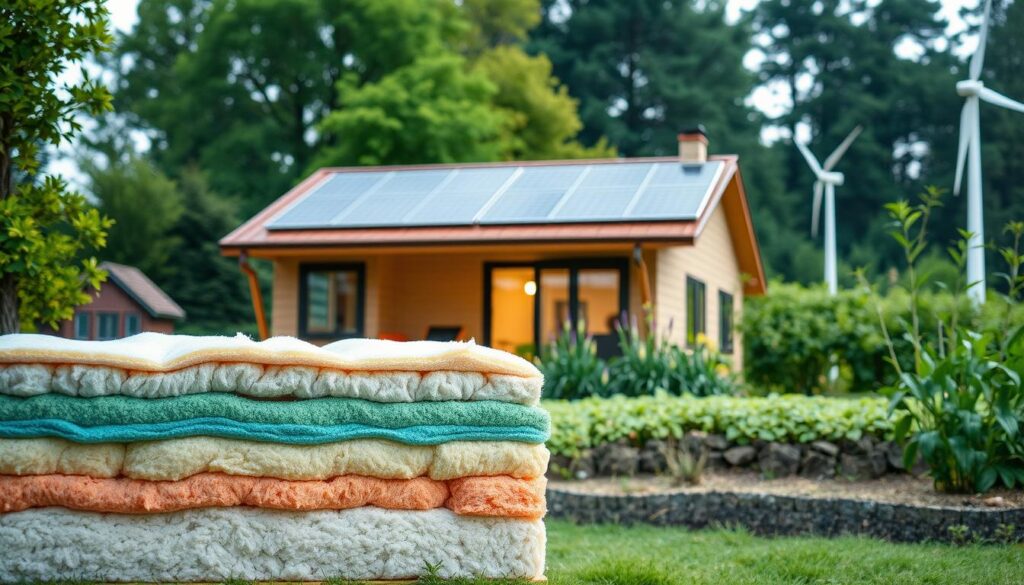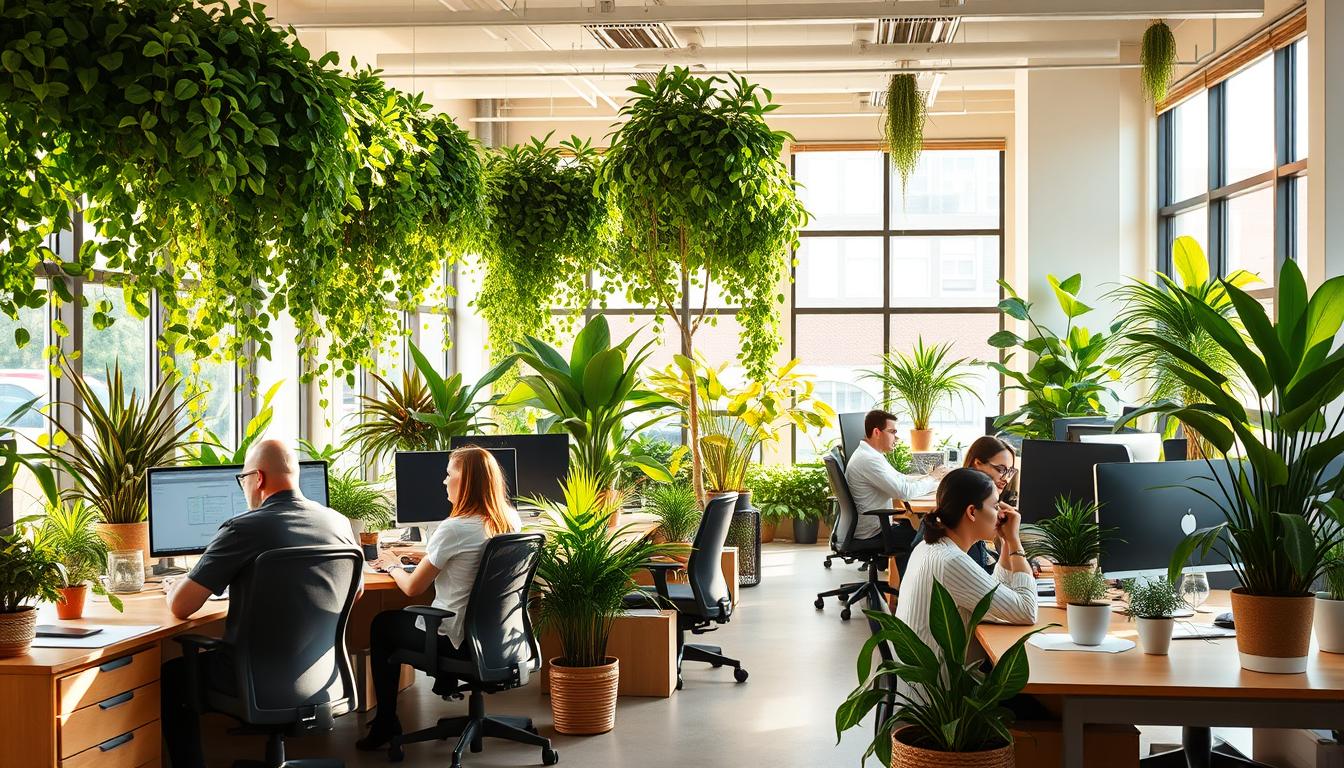Today, sustainable living is more important than ever, and eco-friendly insulation is leading the way. This is especially true in homes. People and builders want green insulation. This insulation makes homes comfy and cuts down on energy use.
Good insulation keeps homes warm in winter and cool in summer. It also lowers the carbon footprint compared to usual materials. Choosing eco-friendly insulation means helping the planet and living better.
The Importance of Eco-Friendly Insulation
Eco-friendly insulation is vital in today’s building methods, especially for green building projects. It boosts energy efficiency, lowers energy use, and cuts down on greenhouse gas emissions. A space that’s well insulated keeps the warmth in during winter and out in summer. This leads to less energy needed for heating and cooling. Such insulation is better for our planet than traditional materials used for the same job.
Energy Efficiency and Environmental Impact
Poor insulation leads to a lot of wasted energy. In fact, homes without good insulation can lose up to 25% of their heat in the winter. This means heating systems have to work harder, using more energy. With better, sustainable insulation, homes are warmer, and energy bills go down. This is good for both the wallet and the world.
Cost Benefits of Green Insulation
Putting money into eco-friendly insulation has great long-term benefits. Even though it might cost more at first, the savings on energy bills over time are significant. Improved insulation means less energy used, which lowers monthly bills. As green options become more common, their prices go down. This makes sustainable insulation easier to get. Choosing eco-friendly insulation is smart money-wise and helps the planet too.

Understanding Eco-Friendly Insulation Materials
In the insulation world, choosing natural or synthetic materials affects sustainability and the environment. Natural materials like sheep’s wool bring benefits such as energy efficiency and less harm to the planet. Synthetic options, although effective, may harm the environment more. Knowing about these helps us pick greener options for the future.
Natural vs Synthetic Insulation Options
Natural insulation, including sheep’s wool and cellulose, offers great performance without hurting the planet. These materials are eco-friendly and help save energy. However, synthetic choices like polystyrene require more energy to make, increasing their environmental impact. Opting for natural insulation supports both eco-friendliness and responsible sourcing.
Environmental Footprint of Insulation Materials
The environmental impact of insulation is key for sustainable building. Natural options are better because they’re easier on the environment and break down naturally. Synthetic materials, on the other hand, can harm ecosystems for a long time. Choosing products with a smaller ecological footprint helps our planet and promotes sustainable building.
Green Insulation in Indoor Environments
Picking green insulation improves the air we breathe inside. It uses safe materials without bad chemicals. This makes homes and buildings healthier places to live. Studies show regular insulation can let out harmful stuff called VOCs, messing up the air. But, eco-friendly insulation keeps the air clean and flowing right. It’s good for everyone inside.
Impact on Indoor Air Quality
Eco-friendly insulation helps make indoor air better. Options like cellulose or sheep’s wool don’t let out bad stuff. So, the air is cleaner, which is great for people with allergies. Keeping the air in our spaces clean makes them nicer and healthier to be in. That’s why choosing the right insulation is super important.
Health Benefits of Using Green Materials
Green insulation does more than just clean the air. It also keeps moisture in check, stopping mold and dust mites. This can mean fewer allergies and breathing problems for people. Plus, these natural materials keep indoor temps comfy. So, living and working spaces feel better overall.
Innovative Materials for Eco-Friendly Insulation
Seeking sustainable building methods, we find leading-edge insulation materials. Sheep wool, Icynene, and Aerogel excel, enhancing energy efficiency and reducing environmental harm. They play a big role in modern construction, offering top-notch insulation.
Sheep’s Wool: Natural and Fire-Resistant
Sheep wool is a natural, effective insulator. It keeps indoor temperatures stable, which saves energy. It can soak up extra moisture without losing its insulating power. This makes it good for many climates. Plus, it’s naturally fire-resistant, making it a safe, eco-friendly choice.
Icynene: A High-Performance Spray Foam
Icynene, made from castor oil, is a cutting-edge insulation method. It expands to fill cracks, creating a solid barrier. This seal stops air flow, boosting energy savings and comfort. It’s also eco-friendly and matches modern sustainable building approaches.
Aerogel: The Super Insulation Material
Aerogel is known as a “super insulation material” for its exceptional thermal resistance and lightness. Despite its thinness, it doesn’t compromise on insulating power. Ideal for tight spaces, Aerogel’s unique qualities make it highly valued in eco-conscious construction projects.
Recycled and Upcycled Materials for Insulation
Recycled and upcycled materials are changing insulation for the better. They offer green solutions that help the planet and homeowners. Using cotton from old jeans, recycled paper, and cork from oak trees improves energy use and cuts landfill waste.
Cotton and Denim Insulation
Cotton insulation comes from recycled denim and resists moisture. It lacks the harmful chemicals found in traditional insulation. Plus, it keeps homes warm effectively and supports clean air inside.
Cellulose: Made from Recycled Paper
Cellulose insulation is made from old paper. It’s eco-friendly, affordable, and works well. It helps keep homes warm without wasting energy. This makes it a top pick for those who care about the planet.
Cork: The Carbon-Capturing Insulation
Cork insulation comes from cork oak tree bark and is great for the environment. It traps carbon and insulates homes well against noise and heat. Cork’s green benefits make it a smart choice for eco-conscious building projects.
Performance Metrics: R-Values and Thermal Resistance
Knowing how insulation performs is key to saving energy. The R-value is a measure that shows how well insulation can stop heat flow. The higher the R-value, the better it is at keeping energy costs down.
Understanding R-Values
The R-value depends on the insulation’s thickness and type. It tells us how good the material is at blocking heat transfer. While standard insulation has R-values around 10, more efficient types can score over 30. Choosing the right R-value is vital, depending on your climate and building needs.
The Importance of Thermal Resistance in Insulation
Thermal resistance helps keep indoor temperatures steady all year. In cold places, you’ll want high R-value insulation to cut down on heating bills. In hot areas, a lower R-value helps manage cooling costs. Picking the right overall R-value boosts energy efficiency and lessens the need for HVAC systems.
Installation Techniques for Eco-Friendly Insulation
Putting in eco-friendly insulation helps cut down on energy bills and makes your home cozier. Some homeowners choose to install it themselves to save costs. However, knowing how to do it right is key. For tougher jobs, it’s wise to hire a pro to ensure everything is safe and works well.
Tips for DIY Installation
If you’re planning to install insulation on your own, here are some helpful hints:
- Check your space and pick the right kind of eco-friendly insulation.
- Make sure you wear safety equipment like gloves, goggles, and masks.
- Always follow the instructions that come with your insulation for the best results.
- Don’t forget about air sealing to make your insulation more effective.
- Getting someone to help you with big projects can make things easier and more accurate.
When to Consult Professionals
Some situations call for the skill of a professional installer:
- Special cases like spray foam require professionals who have the right tools and know-how.
- If you’re making big changes, expert installation ensures everything is up to par and safe.
- Experts are crucial when you need to follow local building codes to avoid problems.
Government Incentives and Programs for Green Building
Governments offer important help for using green insulation. They have programs at both federal and state levels to help homeowners. These help make it cheaper to use green building ways, leading more folks to pick eco-friendly options.
Federal Tax Credits for Eco-Friendly Insulation
Homeowners can get federal tax credits for using green insulation. These credits lower your taxes and promote saving energy. By choosing approved green insulation, you save money and help the planet too.
State-Specific Incentives and Programs
Different states have their own special offers for green insulation. They provide benefits like rebates on costs and extra tax credits. These programs make buildings better and push for caring for the environment.
Conclusion
Choosing eco-friendly insulation is very important for better indoor spaces and supporting the environment. Homeowners can cut down on energy use and help the planet by picking green building solutions. Today’s materials are not only energy-saving but also make indoor air healthier. This makes them perfect for new buildings and fixing up old ones.
We need to spread the word about sustainable insulation to make more people choose it. Homeowners should look for energy-efficient materials when improving their homes. Doing this benefits their health and the earth in the long run.
Builders, architects, and homeowners working together is crucial for eco-friendly building. By joining forces, we can push for insulation that’s good for the environment. This way, we’ll create a better, sustainable future for the next generations.



